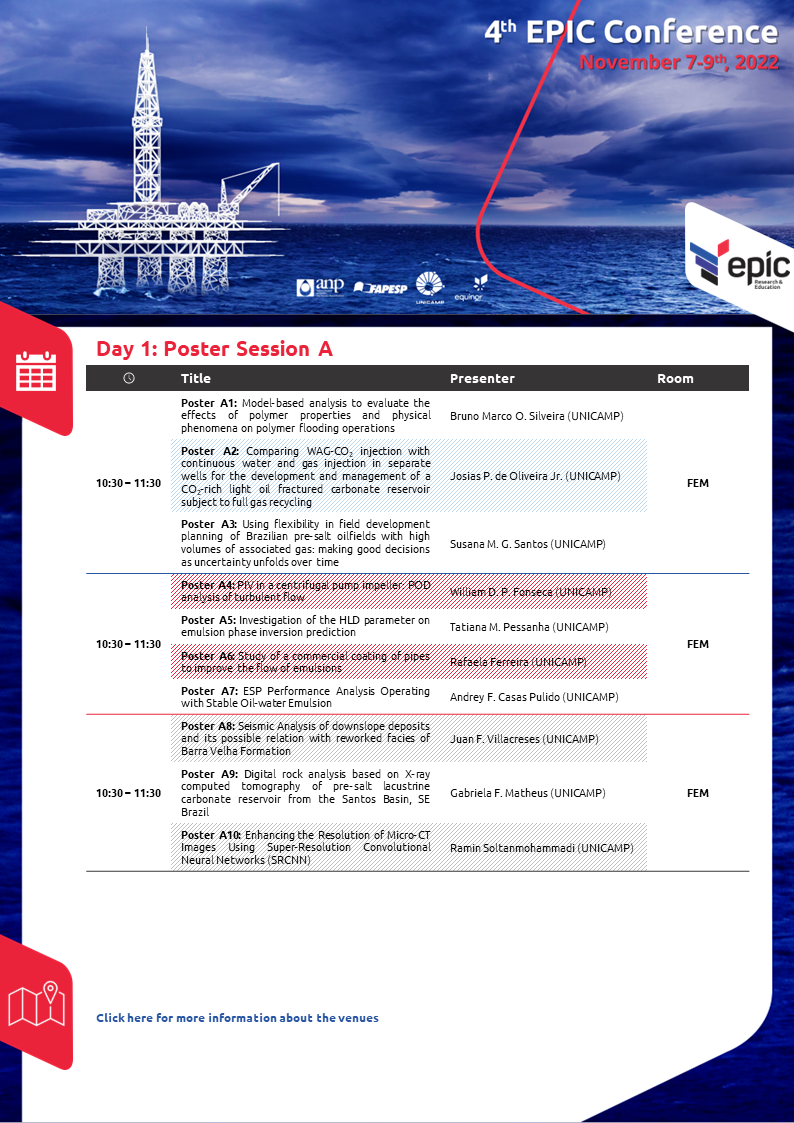Minicurso
Atualização (21 de junho): instruções para os participantes inscritos foram enviadas para o e-mail fornecido na inscrição. Caso não tenha recebido, verifique sua pasta de spam. Quaisquer dúvidas, contacte-nos em epic@unicamp.br
O EPIC gostaria de convidar estudantes de pós-graduação, pesquisadores e profissionais da área de engenharia de reservatórios para o minicurso intitulado “Ensemble based Decision Making in Reservoir Management and Field Development Planning“, a ser oferecido pelo Prof. Remus Gabriel Hanea, consultor chefe em tecnologia de reservatórios na Equinor, e pelo Prof. Bogdan Sebacher, professor na Academia Técnica Militar de Bucareste, Romênia.
O curso será oferecido em inglês, entre os dias 27 e 29 de junho de 2022, na Faculdade de Engenharia Mecânica (FEM) da Universidade Estadual de Campinas (UNICAMP), em Campinas, Brasil.
O Prof. Remus Gabriel Hanea é consultor chefe em Tecnologia de Reservatórios, Ajuste Assistido ao Histórico e Otimização/Tomada de Decisão no departamento de Excelência em Subsuperfície na Equinor. Sua formação é em Matemática Aplicada, e o Prof. Remus tem 15 anos de experiência em Quantificação de Incerteza, Assimilação e Otimização de Dados e Tomada de Decisão com aplicações em Ciências Atmosféricas, Hidrologia e em vários domínios de Energia (principalmente O&G). Ele também é professor em tempo parcial no Departamento de Engenharia de Petróleo da Universidade de Stavanger (Noruega), atuando no grupo de Engenharia de Geociências de Petróleo. Os principais tópicos de pesquisa do Prof. Remus são: ajuste assistido ao histórico e otimização robusta para gerenciamento de reservatórios, valor da informação, decisão e análise de risco e geoestatística. O Prof. Remus ministra também curso especializado para alunos de Doutorado e Mestrado em Modelagem Inversa, Assimilação e Otimização de Dados com aplicações em Gestão de Reservatórios, além de orientar alunos de Mestrado e Doutorado.
O Prof. Bogdan Sebacher é professor associado junto à Academia Técnica Militar de Bucareste (Romênia).
Programa do Curso
Dia 1
(27 de junho de 2022)
Introduction to Reservoir Management and Data Assimilation
Período da Manhã (9:00 às 12:00)
- Introduction to Reservoir Management and Field Development Planning – basic notions
- Introduction to Data Assimilation and Decision Making/Optimization – basic notions
- Models, Data, Uncertainties
- Bayes Theorem
- Kalman Filter
Período da Tarde (14:00 às 17:00)
- From Ensemble Kalman Filter (EnKF) to Ensemble Smoother Multiple Data Assimilation (ES-MDA) – the journey
- Pros and Cons and practical implementations (case studies)
- Ensemble validation and analysis, Quality assurance and the definition of success
Dia 2
(28 de junho de 2022)
Facies modeling and estimation
Período da Manhã (9:00 às 12:00)
- Pluri-Gaussian approach
- Adaptive Pluri-Gaussian Simulation (APS)
- Probability cubes for facies distributions – Seismic and log data information
Período da Tarde (14:00 às 17:00)
- Multipoint Geostatistics (MPS) approach
- Parameterization and estimation
- Machine learning approaches
Dia 3
(29 de junho de 2022)
Decision Making/Optimization under geological uncertainties
Período da Manhã (9:00 às 12:00)
- Robust/Ensemble Optimization
- Basic concepts
- Ensemble and stochastic gradient optimization approaches
- Practical Implementations
- Way forward – Structured decision making approach

 Day 1: General Program
Day 1: General Program Day 1: Poster Session
Day 1: Poster Session Day 2: General Program
Day 2: General Program Day 2: Poster Session
Day 2: Poster Session Day 3: General Program
Day 3: General Program